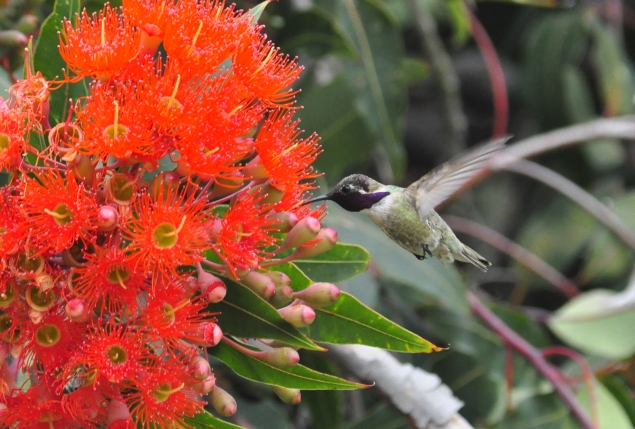Costa's Hummingbirds make everything better. Fort Rosecrans National Cemetary, San Diego, CA.
As you know, migration is winding down, and its no longer easy to head out and get a bunch of year birds whenever you go birding. Here in SoCal its a great time of year for vagrants, but that too will soon pass. The Birder's Summer is about to set in.
As I do most springs, I've been working feverishly and have been unable to get to many destinations that get a lot of colorful migrants...once again, places like High Island, the Dry Tortugas and Magee Marsh will have to wait, and my life list remains without a Cerulean Warbler. There's always next year I guess.
Some California birders loathe March, June and July in general, although July can be decent for shorebirds and seabirds. I'm not sure how I'll cope this year. I suspect beer will help.
Western Wood-Pewees are still moving through California in late May, but it's more of a dribble than a stream. Fort Rosecrans.
Bostick has had a successful trip to Maine, and has a significant lead on me in our half-assed big year competition. That bastard. You know it's really hard to win a big year competition when part of your big year strategy is deliberately avoiding going way out of your way just for year birds. Sigh.
Right. Well here's some birds to look at, a mix of local summer residents and some of the more fleeting spring migrants. Time to buckle down for summer.
Hooded Oriole. Common in San Diego. Still great to look at. Fort Rosecrans.
This is an extremely familiar bird to a lot of you reading this, but it is not a bird to scoff at in California. This teenaged male Baltimore Oriole was one of the rarer birds I saw this month. Fort Rosecrans National Cemetary.
Behold the massive intellect of the Baltimore at work. It's prying open that Eucalyptus with its bill. Why?
To obtain a giant, extremely flat bug of course. When in doubt, pry.
Beginning birdwatchers who bitch about their impotence at sparrow identification have never laid eyes on a Black-chinned Sparrow, who are attired somewhere in between the exotic realms of Facemelt and the simple but chic Economy of Style. Kitchen Creek Road.
The first time I ever heard a Field Sparrow I was floored...they sound exactly like these guys.
Another black-faced bird with a chestnut back...but with the gray swapped for something more extravagant. Blue Grosbeak. Tijuana River Valley, CA.
Olive-sided Flycatcher. It was foraging for three beers. Stonewall Mine, Cuyamaca Rancho State Park.
I never realized how wide their bills are...surely an adaptation for efficiently consuming three beers. Stonewall Mine.
Looking at this makes me sleepy. White-winged Dove. Agua Caliente County Park, CA.
Calliope Hummingbirds were easy to see this year at Point Loma...maybe there is a god. Fort Rosecrans.
Another rare bird, but not something that fits in very well on a checklist. This is an Audubon's X Myrtle Yellow-rumped Warbler, full of hybrid vigor. Old Mission Dam, San Diego, CA.














Orioles! Jealous... What makes the YR Warbler a hybrid? Just curious. I haven't even seen one since before I left for my trip. How weird is that.
ReplyDeleteAudubon's in breeding plumage lack the black-masked appearance and white supercilium of Myrtle's; you can also see a white border to the yellow throat patch (this is more apparent in some other pictures).
DeleteAwww you've got it soo hard with Calliope Hummers and Orioles all around ya.
ReplyDeleteIs that remarkable bush with the Costa's the same one where you found a Prothonotary a few weeks ago?
Anyhow, it looks like you're doing ok Seagull, though of course that's no reason not to drink lots and lots of beer, especially if the Olive-Sided Flycatcher will join you (for my money, I would've bet he fancied martinis).
I think you've got more orioles than I do Laurence! The only really common one here now is Hooded. The Calliopes were great but I only saw them a couple days before they disappeared.
DeleteAlthough not the same tree, it is the same kind (a red-gum eucalyptus) and is a short walk from the tree the PROWAR preferred.
Love the colours of your birds, beautiful!
ReplyDeleteI would say "thank you", but I have nothing to do with how good they look...
DeleteWhat a delightful variety of birds! There are quite a few that I would love to see and photograph.
ReplyDeleteLove these shots. Thanks!
ReplyDelete